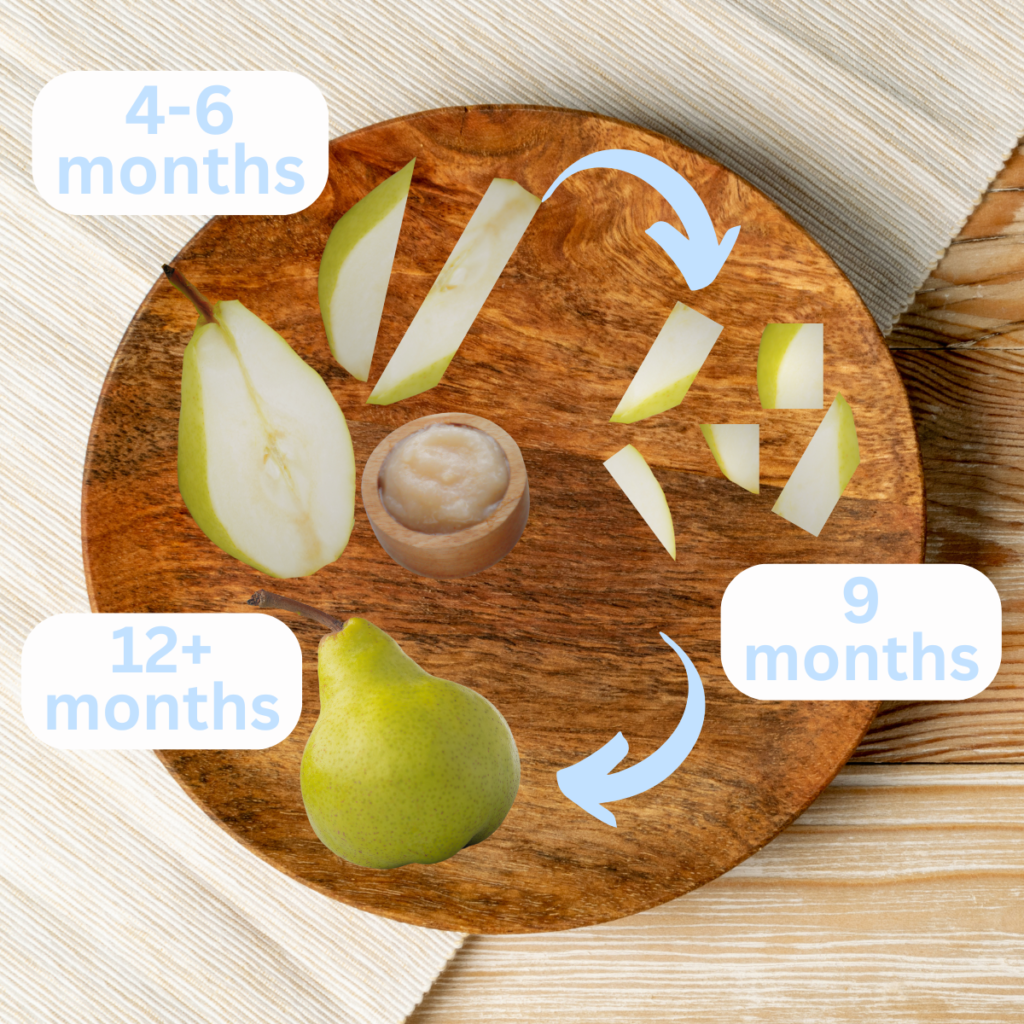If you have a hungry baby but are unsure how to use pears in baby-led weaning, this post is for you! As a pediatric registered dietitian, I often recommend incorporating pears in baby-led weaning because of their sweet taste, easy texture, and benefits to your baby’s gut health.
Baby Led Weaning (BLW) is an approach to introducing solids that allows your baby to self-feed right from the beginning. Rather than spoon-feeding purees, you offer a range of whole foods that your baby can explore, pick up, and eat at their own pace.
Selecting the right foods for BLW is essential for your baby’s safety and nutritional intake. Foods should be soft enough to gum, large enough to grasp, and packed with nutrients to support your baby’s rapid growth and development. That’s where pears come in!
This comprehensive guide will cover everything you need to know about using pears in your baby-led weaning journey. We’ll provide preparation tips, safety guidelines, and creative serving ideas. Let’s get started!
Why Pears are Great for Baby-Led Weaning
High In Vitamins and Minerals
Pears are packed with essential nutrients that are perfect for your baby’s growth and development such as:
- Vitamin C: One pear has about 15% of your baby’s daily vitamin C needs. This helps support a healthy immune system and increases the absorption of iron from other foods.
- Vitamin K: One pear has more than 3 times the daily vitamin K needs of your weaning baby. Because other sources of Vitamin K like leafy greens are not often used in baby-led weaning, pears are a great alternative.
- Fiber: Pears pack a full 6 grams of fiber which is incredibly helpful because constipation is a common issue when starting solids.
Soft for Teething Gums
When ripe or cooked, pears are soft and juicy, making them easy for babies to chew and swallow, even if they don’t have teeth yet. This reduces the risk of choking and ensures that your baby can handle the food comfortably.
Easy to Hold and Manage for Little Hands
Pears can be sliced into wedges or chunks that are perfect for small hands to grasp. This not only makes them easy to eat but also helps your baby develop their fine motor skills and hand-eye coordination.
If the pears are slipping from your baby’s hands, keep the skin on for an easier grip.
Low Allergy Risk
Pears are also a great choice because they are not a top 8 allergen food, so the risk of having an allergic reaction is lower.
Like any new food, introduce pears first in small servings and continue if no adverse reactions occur.
When and How to Use Pears in Baby-led Weaning
Recommended Age for Introducing Solids:
The ideal age for starting solids, including pears, is 4-6 months. At this age, most babies have developed the necessary motor skills and digestive capabilities to handle solid foods.
Signs Your Baby is Ready for BLW:
Before introducing pears or any other solid food, look for the following signs that indicate your baby is ready for baby-led weaning:
- Your baby can sit up with minimal or no support.
- They have good head control.
- They show interest in food, such as reaching for or watching what you eat.
- They can grasp objects and bring them to their mouth.
- They have lost the tongue-thrust reflex, which means they no longer automatically push solids out of their mouth with their tongue.
Step-by-Step Guide to Preparing Pears for Your Baby:
Use cooked or very ripe pears:
If pears are not ripe, they can be a choking hazard for infants. You want your pear to be ripe enough to easily squish when pressed between fingers. If your pear isn’t ripe enough, cook your pear by boiling, sauteing, or roasting.
Avoid using canned pears that are soaked in sugar syrup or fruit juice. Look for ones with minimal added sugar or soaked in water. Try to avoid pear-based products that have artificial sweeteners like sucralose or stevia.
Prepare based on their age:

4+ months: mashed or halved
- Mashed: smash the ripened or cooked pears into a puree or mixed into other soft foods like oatmeal, yogurt, or guacamole
- Thin Strips: Use very ripe or cooked pears that have been pitted. Slice lengthwise into ½ “ wedges. You can keep the skin on or off!
- Halves: Serve skin on or off, pitted and ripe
9+ months: thin bite-sized pieces
As babies develop more oral and fine motor skills, offer the pear in smaller pieces. Again, offer well-ripened or cooked pears with the skin on or off. Cut the pieces in flat, thin slices.
This gives your baby practice in their pincer grasp which is starting to develop around 9-10 months old.
18+ months: halved or whole
After one year old, kids have developed enough oral motor skills to eat a whole pear. Although they might spit out some of the skin, they are simply learning to use their teeth!
Recipes with Pears for Baby-led Weaning
Serve pears by themselves or throw them into different recipes! Try any of these easy recipes:
As you embark on baby-led weaning, remember to be patient and observe your baby’s cues. Each baby is unique, and it may take time for them to get accustomed to new foods and textures.
For more information on baby-led weaning, check out my high iron foods for baby-led weaning post here.
This post may contain affiliate links, meaning I will receive a commission if you deicide to make a purchase through my links, at no cost to you. For more information, please read my Terms of Use and Service.

Pingback: Why And How To Make Pear Juice At Home